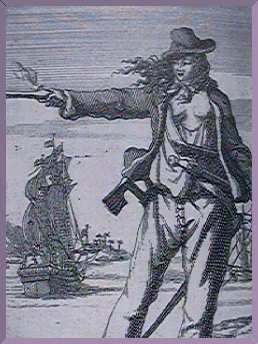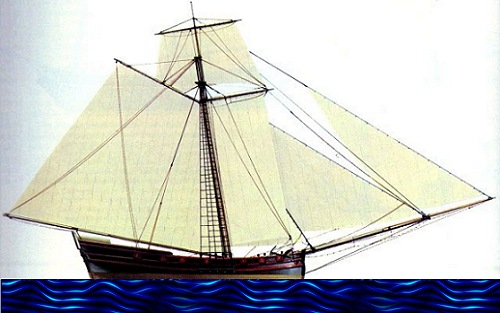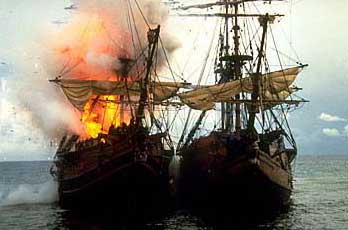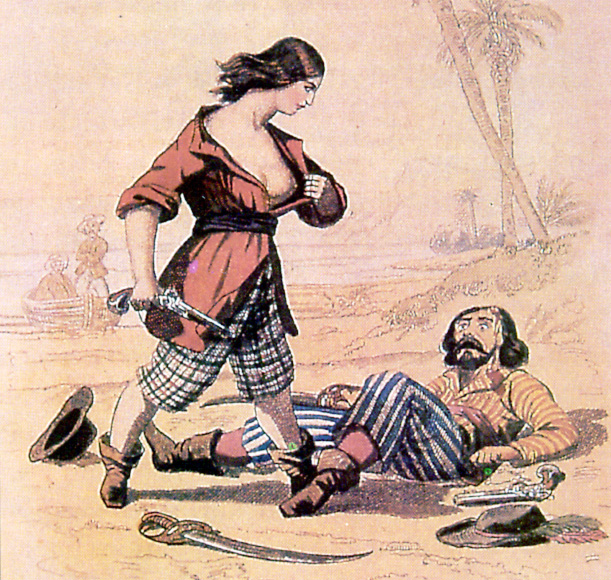
This a modern map of the eastern Carribean. Please note the following:
The Bahamas represent literally thousands of islands, many connected in great stretches of shoal water built up on ancient reefs--a perfect place for the pinnaces and small sloops of smugglers and pirates to elude the
Costa Garda or prowling French, English or Dutch frigates. In the 17th century, the English established settlements at Eleutheria, Grand Bahama, Nassau (hey, they stole it from the Dutch, fair and square) and New Providence. Not shown are the Florida Keys, where the French Huguenots set up very transitory pirate havens. Often, they simply landed on the nearest "Key" and divvied up on the spot. Cuba raised a good deal of cattle for export to the Spanish main, and when livestock were taken, a call went out to all local boys that a big cook-out was to be held. A barbican is the cross-barred iron gate of a stone keep, and one of these was often kept aboard for just such occassions--and hence, the English corruption of the French spelling into barbeque, as whole carcasses could be roasted on a barbican. The French also called them
boucans, from a Tipu Indian word, and thus gave rise to the name buccaneer.

 In the old print, note the boucan in the background, and in the lower left hand corner. The image to the right is of a modern recreation of the original Tipu boucan, which was designed to smoke meat for preservation, more than to cook it.
In the old print, note the boucan in the background, and in the lower left hand corner. The image to the right is of a modern recreation of the original Tipu boucan, which was designed to smoke meat for preservation, more than to cook it.
Where you see Haiti and the Dominican Republic, you are looking at the island of Hispaniola, the first of the Greater Antilles visited by Columbus. The Spaniard was long settled at Santo Domingo on the south coast at the eastern end, but as the rest was swampy, heavily forested and surrounded by shoal water, not much effort was made to settle it. The French established fortified outposts at Tortuga (actually a separate island at the northwest corner), Port-de-Paix, Leogane and Petite Goave.
The island of Jamaica was an on-again, off-again project of the Spaniard, which really never got off the ground, because of the poor soil of the interior. But in the 1650's, the Barebones Parliament under the thumb of Oliver Cromwell sent an expedition there, lead by Cromwell's younger, capable son. A stronghold was established at the eastern end of the south coast, which faced the Spanish Main (the north coast of South America), and this was named Port Royale after the restoration of the monarchy.
The many islands of the Virgins were unsettled, and used as ad hoc havens by the pirates and smugglers.
St. Martin was the earliest Dutch stronghold, followed by St. Eustasius (not shown) to the southeast. Then the emboldened Dutch set up on Curaçao, just to the north of Lake Maracaibo, and traded freely and illegally with the Spanish Main cities of Maracaibo, Coro, Puerto Cabello, Caracas, Cumana and Margarita.
The English first set-up at Barbados, and the French quickly countered by establishing Monserrat (not shown, north of Guadaloupe), Guadaloupe and Martinique. The English then moved to take Antigua, Nevis and St. Kitts. The islands to the south--St. Lucia, St. Vincent, Grenada and Tobago were unsettled in the 17th century heyday of the pirates and smugglers, and were often used as havens. Trinidad was just about the most lawless and huge smugglers den in the mid-17th century, until the Spaniard came to take it in a desparate and futile attempt to end the smuggling. The islands south of Martinique were known as the Windward Islands, because of the prevailing east-southeast trade winds, and those to the north as the Leeward Islands, beause they were "in the lee" of the southern islands, which is to say, away from the wind.











 .
. 


















